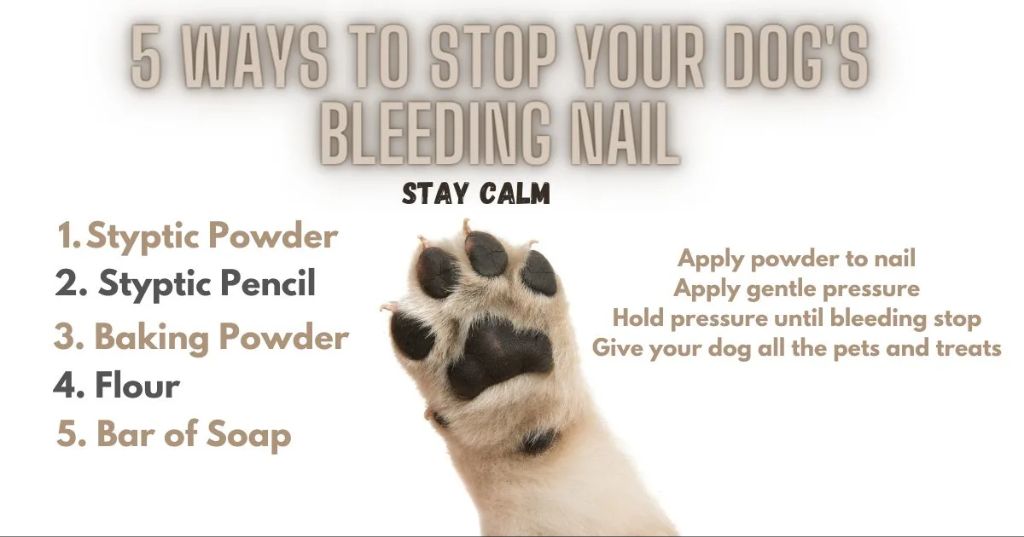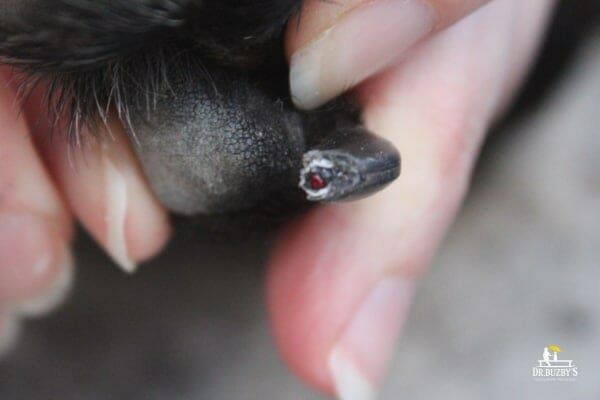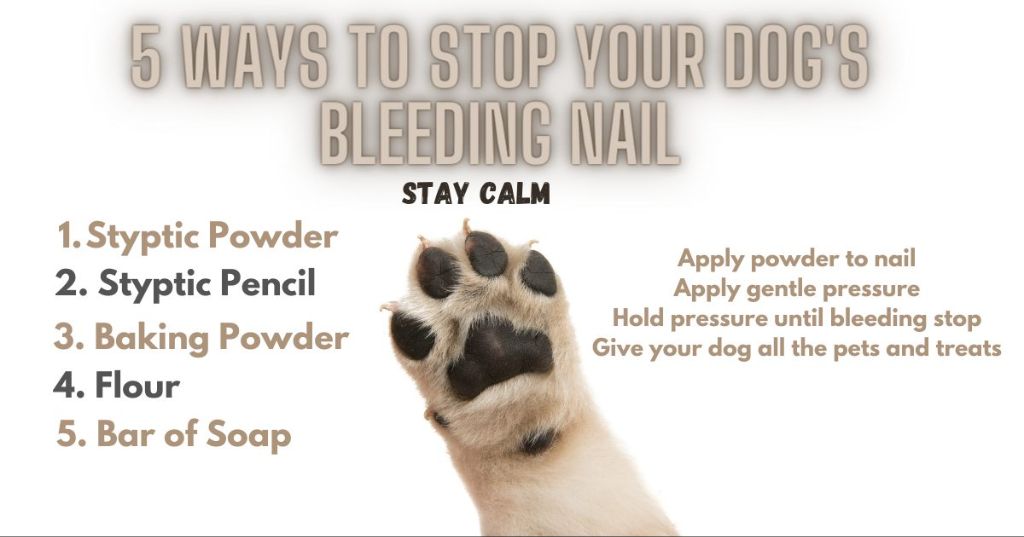Introduction
Nail bleeding is a common issue that dog owners may experience, especially after trimming their dog’s nails. Seeing blood coming from your dog’s paw can be very alarming, but luckily there are ways to stop minor nail bleeding at home without an emergency vet visit.
One of the best natural home remedies for stopping minor nail bleeding in dogs is baking soda. Many dog owners likely already have baking soda on hand in their pantry. Applying baking soda is an easy, inexpensive, and effective way to quickly stop nail bleeding after a toenail has been trimmed too short.
In this article, we will cover how and why baking soda works to stop nail bleeding in dogs. We provide step-by-step instructions on properly applying baking soda to stop the bleeding. We also discuss other home remedies, when you should see the vet, and how to prevent excessive nail bleeding in the future through proper nail trimming technique.
What Causes Nail Bleeding in Dogs
There are several common causes of nail bleeding in dogs:
-
Ingrown nails – This occurs when the nail starts to grow into the paw pad or side of the toe, causing irritation and bleeding. It is often caused by nails being allowed to grow too long.
-
Trauma from hard surfaces – Running and playing on concrete, asphalt, rough terrain, etc. can cause nails to crack, split or break, leading to bleeding.
-
Nail trimming accidents – Cutting the nail too short when trimming can cut the quick (blood vessel inside the nail), causing pain and bleeding.

According to this source, nail trimming is the most common cause of bleeding nails in dogs. Cutting into the quick while trimming causes bleeding and pain. Keeping nails properly trimmed can help prevent ingrown nails and damage from hard surfaces.
Why Baking Soda Works
Baking soda, also known as sodium bicarbonate, is effective at stopping dog nail bleeding because it acts as a natural clotting agent. The sodium bicarbonate interacts with blood proteins and platelets to help form clots more quickly (Wong, 1980). This helps seal the wound and prevent further blood loss.

In addition, baking soda has antimicrobial properties. This means it inhibits the growth of microorganisms. By preventing infection in the wound, baking soda helps create an optimal environment for quicker clotting and healing.
Overall, these two key attributes make baking soda a readily available and easy-to-use home remedy for stopping bleeding from a dog’s torn nail.
How to Apply Baking Soda
Once you have located the bleeding nail, it’s time to apply the baking soda. This is best done by restricting your dog’s movement so they don’t make more of a mess or injure themselves further. The easiest way is to place your dog in a bathtub. If that’s not possible, confine them to a small area using baby gates.
Have some baking soda handy and pour it directly onto the bleeding nail. You’ll need enough to cover the entire nail. Then take a clean towel or some gauze and apply steady pressure to the nail for 5-10 minutes. The baking soda will help absorb and clot the blood.
According to CanadaPetCare, the clotting action of baking soda makes it an effective home remedy for stopping bleeding from a dog’s over-trimmed nail.
When to See the Vet
While baking soda is an effective home remedy for minor nail bleeding, there are times when you need to seek veterinary attention. If the bleeding does not stop after 15-20 minutes of applying baking soda, the nail may be damaged too severely for clotting to occur properly. Prolonged bleeding can lead to blood loss, and your dog may need advanced treatment to cauterize the wound. You should also take your dog to the vet if the nail is broken off, partially detached, or the tear extends into the nail bed. This level of damage often requires medication or surgery.
Signs of a nail infection after a tear are also cause for an urgent vet visit. Look for redness, swelling, oozing pus, foul odor, and persistent lameness around the nail. An infection that goes untreated can spread up the foot. Vets will prescribe antibiotics and may give other treatments to resolve the infection.
It’s always a good idea to have your vet examine a damaged nail within 24 hours, even if the bleeding stops with home care. They can properly assess the injury, rule out complications, and determine if any follow-up care is needed for proper healing. Don’t wait with serious nail injuries, as prompt treatment gives the best outcome.
Sources:
https://www.medvet.com/what-to-dog-if-your-dog-breaks-or-tears-a-nail/
https://wahlusa.com/expert-advice/grooming-pets/how-treat-dog-nail-bleeding-during-trimming
Aftercare
Proper aftercare is essential to help stop further bleeding and prevent infection after nail bleeding in dogs. According to Wahl USA (https://wahlusa.com/expert-advice/grooming-pets/how-treat-dog-nail-bleeding-during-trimming), it’s important to keep the dog restricted and calm following an incident of nail bleeding. Limit their activity and prevent them from running around or jumping, which could disrupt clotting and cause renewed bleeding.

Additionally, monitor the nail closely over the next several hours and days for any signs of rebleeding. Apply a small amount of antibiotic ointment to the nail, advises VCA Animal Hospitals (https://vcahospitals.com/know-your-pet/first-aid-for-broken-nails-in-dogs), to prevent infection in the nail bed. Consider using soft nail caps or booties temporarily to protect the sensitive nail while it heals.
With proper aftercare watching for renewed bleeding, protecting the nail, and applying antibiotic ointment, the nail should heal well after a minor bleed.
Preventing Future Bleeding
Regular nail trims are key to preventing future bleeding episodes when trimming your dog’s nails. Trimming just a small amount every 1-2 weeks helps keep the quick short and reduces the likelihood you’ll cut into it. Many vets and groomers recommend weekly nail trims.
Providing soft surfaces for your dog to walk on also helps wear down nails naturally between trims. Carpeting, rugs, and dog beds give just enough abrasion to keep nails filed down. Take your dog for walks on concrete or paved paths when possible too.
Monitor nail length closely in-between trims. If you hear nails clicking loudly on the floor, it’s time for a trim. Long quicks can grow out deep inside the nail, making them prone to bleeding when cut.
With diligent regular trimming schedules and abrasive surfaces for walking, you can help prevent those unpleasant bleeding scenarios. Just a little proactive care keeps nails short and your dog comfortable.
Other Home Remedies
In addition to baking soda, there are a few other common household items that can help stop bleeding from a dog’s nail:
Flour – Plain white flour contains vitamin K, which can promote blood clotting. Make a paste by mixing flour with a small amount of water. Apply the paste to the bleeding nail and hold it there firmly for 5-10 minutes.
Cornstarch – Like flour, cornstarch can help clot blood when applied topically. Mix cornstarch with a bit of water to form a paste. Press it onto the nail for several minutes until bleeding stops.

Bar soap – Dragging the nail over a bar of soap can help seal the wound. The soap helps clean the area while activating platelets for clotting. Gently rub the nail back and forth over the bar soap for 30-60 seconds.
While these home remedies may help temporarily stop bleeding, it’s still a good idea to see your vet if nail bleeding persists. They can properly cauterize the nail and provide antibiotics if needed.
When to Avoid Baking Soda
While baking soda can be safe and effective to stop minor nail bleeding in dogs when used properly, there are some situations where it should be avoided:
Open wounds – Baking soda should not be used on deep, open wounds or puncture wounds, as it can irritate the exposed tissue. The abrasive texture of baking soda could delay healing if packed into an open wound. It’s best to avoid baking soda and see a vet if your dog has a significant open wound on the paw or nail bed.
Ingestion risks – Baking soda should not be consumed in large quantities by dogs, as it can potentially cause electrolyte abnormalities and stomach discomfort. You’ll want to rinse off any baking soda applied to nails to reduce the risk of licking and swallowing. Monitor your dog after use and call your vet if you notice vomiting, diarrhea or lethargy.
Sensitive skin – While rare, some dogs may be sensitive or allergic to baking soda. Discontinue use if you notice signs of skin irritation, rash, or inflammation after applying baking soda to nails. Stick to veterinarian-recommended products if your dog seems sensitive.
Deep nail infections – If the nail bed appears infected, swollen, or abscessed, don’t use baking soda. These cases require prescription antibiotics and treatment. See your vet promptly if the nail bed is painful, inflamed or oozing.
Summary
Baking soda is an effective and low-cost home remedy to help stop dog nail bleeding. When applied directly to the nail bed, baking soda’s natural astringent and antiseptic properties will promote clotting and help disinfect the area.
To properly use baking soda for nail bleeding in dogs, gently press a small amount onto the nail bed for 5-10 minutes or until bleeding stops. Avoid getting baking soda into the wound. Keep the dog calm and restrict activity while applying pressure. Check that bleeding has fully stopped before removing the baking soda.
After application, clean the paw and monitor for recurrence of bleeding. Keep the nail dry and clean while it heals. Seek veterinary care if bleeding persists or for signs of infection like pus, redness/swelling, or fever.
With prompt first aid using baking soda, most minor nail bed bleeding can be treated at home. However, prevention is ideal – keep nails trimmed and avoid injury to the quick.